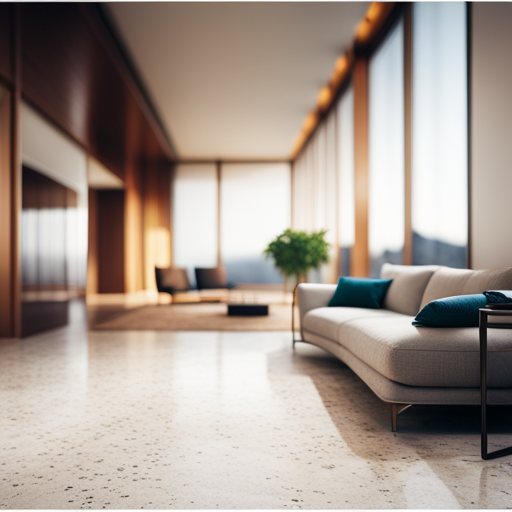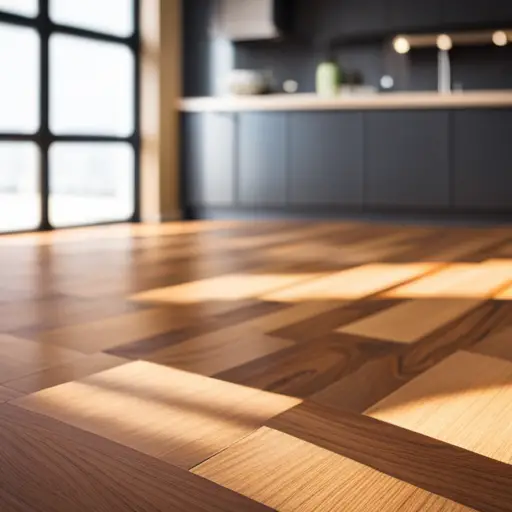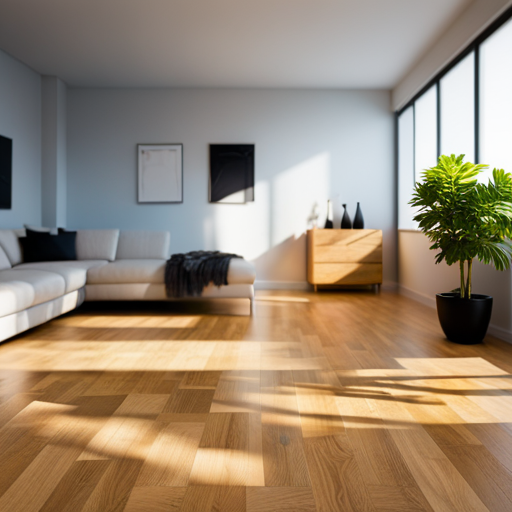Heated Flooring Systems for Cold Climates

Step into a world of unparalleled comfort and warmth with heated flooring systems designed for cold climates.
From frosty mornings to icy nights, these innovative systems offer a luxurious solution to combat the chill.
Discover the ultimate in home heating technology as we explore the benefits, types, installation considerations, energy efficiency, and maintenance tips for heated flooring.
Elevate your living space with the cozy embrace of heated flooring, enhancing both comfort and well-being in the harshest of winters.
The Benefits of Heated Flooring
While there are various heating options available, heated flooring offers distinct advantages for maintaining comfortable indoor temperatures in cold climates. This innovative heating solution provides an even distribution of heat across the floor, ensuring a consistent and cozy environment throughout the living space. Unlike traditional heating methods that often result in uneven temperatures within a room, heated flooring promotes uniform warmth, enhancing the overall comfort of the living area.
Additionally, this system allows for precise temperature control, enabling individuals to tailor the heat according to their preferences, thus contributing to a truly comfortable living experience.
Moreover, heated flooring eliminates the need for unsightly radiators or vents, freeing up valuable wall and floor space for furniture and decor. This not only enhances the aesthetic appeal of the interior but also offers more flexibility in room layout and design. The seamless integration of heating into the flooring also reduces the circulation of dust and allergens, contributing to a cleaner and healthier indoor environment.
Ultimately, heated flooring systems not only provide efficient temperature control but also significantly contribute to a comfortable and inviting living space in cold climates.
Types of Heated Flooring Systems
When it comes to heated flooring systems, there are several types available to suit different needs and preferences.
Electric floor heating, hydronic radiant floor, and radiant air floors are among the most common options.
Each type has its own set of characteristics, advantages, and considerations that make them suitable for various applications.
Electric Floor Heating
Electric floor heating systems are a popular choice for providing efficient and comfortable warmth in cold climate regions. These systems utilize heating cables installed beneath the flooring to generate radiant heat, ensuring an even distribution of warmth across the entire floor surface. The heating cables are often embedded in thinset or self-leveling mortar, providing an effective heat transfer mechanism. Electric floor heating systems offer precise temperature control, allowing users to set the desired flooring temperature according to their comfort. The following table illustrates the key types of electric floor heating systems commonly used:
| Type of Electric Floor Heating System | Description |
|---|---|
| Heating Cable Systems | Consist of heating cables installed in a serpentine pattern for coverage |
| Heating Mat Systems | Feature pre-spaced heating cables woven into a mat for easy installation |
These systems are suitable for various flooring materials, including tile, stone, laminate, and engineered wood.
Hydronic Radiant Floor
Among the various types of heated flooring systems, the hydronic radiant floor stands out as a reliable and efficient option for cold climate regions. Its energy efficiency is a key advantage, as it operates by circulating hot water through a network of tubing installed beneath the floor. The water is heated using a boiler or a water heater, which allows for even distribution of warmth across the entire floor surface.
The installation process involves laying down the tubing within the floor structure, which can be integrated into various flooring materials such as concrete, tile, or wood. This method provides consistent heating and can be controlled through zoning, offering flexibility and further energy savings.
Following the discussion of hydronic radiant floors, the subsequent section will delve into the topic of radiant air floors.
Radiant Air Floors
The discussion of heated flooring systems continues with a focus on Radiant Air Floors, another type of efficient and effective heating option for cold climate regions.
Radiant air technology utilizes a network of air channels installed beneath the floor to distribute warm air, providing consistent and efficient heating.
This type of underfloor heating ensures precise climate control, offering a comfortable environment while maximizing energy efficiency.
Here are four key points to consider about Radiant Air Floors:
- Utilizes radiant air technology for heating.
- Offers energy efficiency and cost-effectiveness.
- Provides precise climate control for enhanced comfort.
- Ensures even heat distribution across the floor surface.
As we delve into the benefits and considerations of Radiant Air Floors, it’s essential to also explore installation considerations for cold climates.
Installation Considerations for Cold Climates
When installing heated flooring systems in cold climates, proper insulation is crucial to ensure efficient and effective heat distribution. Frost protection is a significant consideration when installing heated flooring systems in cold climates. The insulation requirements are essential to prevent heat loss and to maintain the desired temperature within the space.
In cold climates, the flooring system should be installed on top of a well-insulated subfloor to minimize heat loss and ensure that the heat is directed upwards into the room rather than being absorbed by the ground below. Additionally, the insulation should extend to the perimeter of the heated area to prevent cold air infiltration and ensure uniform heating.
It is important to use insulation materials with high R-values to provide maximum thermal resistance and minimize heat transfer. Proper insulation not only enhances the performance of the heated flooring system but also contributes to energy efficiency and cost savings in the long run. Therefore, paying close attention to insulation requirements is crucial when installing heated flooring systems in cold climates.
Energy Efficiency and Cost Savings
To achieve optimal energy efficiency and cost savings with heated flooring systems in cold climates, careful consideration of insulation and heating controls is essential. Here are four key strategies for maximizing energy efficiency and cost effectiveness:
-
Proper Insulation: Adequate insulation is crucial for preventing heat loss and ensuring that the heated flooring system operates efficiently. Insulating the subfloor and the surrounding walls helps to retain the warmth generated by the system, reducing the overall energy consumption.
-
Programmable Thermostats: Installing programmable thermostats allows for better control over the heating system, enabling users to set specific temperatures for different times of the day. This helps to minimize energy usage by adjusting the heating levels based on occupancy and preferred comfort levels.
-
Flooring Material Selection: Choosing flooring materials with good thermal conductivity can enhance the efficiency of the heated flooring system. Materials that transfer heat effectively contribute to maintaining a comfortable temperature with minimal energy input.
-
Regular Maintenance: Keeping the heated flooring system well-maintained is essential for optimal energy efficiency and cost savings. Periodic checks and maintenance ensure that the system operates at peak performance, reducing energy wastage and prolonging the system’s lifespan.
Maintenance Tips for Heated Flooring
Maintaining heated flooring systems in cold climates requires regular checking and upkeep to ensure optimal performance and longevity.
One of the key maintenance tips for heated flooring is temperature control. It is essential to regularly monitor and adjust the temperature settings to ensure efficient operation and to prevent overheating or underheating, which can lead to premature wear and tear. Additionally, proper temperature control helps in maximizing energy efficiency and reducing operational costs.
Another crucial aspect of maintenance is ensuring the longevity and durability of the heated flooring system. This involves conducting periodic inspections to check for any signs of damage, such as cracks or malfunctions in the heating elements. Addressing any issues promptly can prevent further deterioration and extend the lifespan of the system. Furthermore, cleaning the flooring surface regularly with manufacturer-approved products can help preserve its quality and prevent any potential damage.
Enhancing Comfort and Well-being
As we continue our exploration of heated flooring systems, it’s important to consider the ways in which they can enhance comfort and well-being in cold climates.
From providing warmth to chilly floors to offering potential health benefits associated with warmth, heated flooring systems have the capacity to greatly improve the overall experience of living in a cold climate.
Let’s now delve into the specific points that highlight the comfort and well-being advantages that come with heated flooring systems.
Warmth for Chilly Floors
Enhancing comfort and well-being in cold climates can be achieved through the installation of heated flooring systems. When considering warmth for chilly floors, it’s essential to explore insulation options and temperature control to ensure optimal comfort. Here are four key factors to consider:
-
Efficient Insulation: Proper insulation beneath the heated flooring system helps retain warmth and prevents heat loss, ensuring a cozy environment.
-
Customizable Temperature Settings: Advanced systems offer precise temperature control, allowing users to adjust the heat levels according to their preferences.
-
Even Heat Distribution: Quality heated flooring systems provide uniform heat distribution across the entire floor space, eliminating cold spots for consistent warmth.
-
Energy Efficiency: Modern systems are designed to be energy-efficient, reducing heating costs while providing a comfortable living environment.
Health Benefits of Warmth
The implementation of heated flooring systems ensures a consistent and comfortable warmth, fostering an environment conducive to improving overall well-being and health in cold climates. Improved circulation is a key benefit of warmth, especially in colder regions where extremities are prone to discomfort. Heat encourages blood vessels to dilate, promoting better blood flow and oxygen delivery to the body’s tissues. This can alleviate conditions like cold feet and hands while also supporting cardiovascular health.
Furthermore, warmth serves as an effective relaxation therapy, reducing muscle tension and stress. This can contribute to better sleep quality and overall mental well-being. By providing a consistent and pleasant warmth, heated flooring systems play a crucial role in enhancing comfort and fostering better health in cold climates.
Frequently Asked Questions
Can Heated Flooring Systems Be Installed in Older Homes With Existing Flooring?
When considering installing heated flooring systems in older homes with existing flooring, it’s crucial to evaluate flooring compatibility and retrofitting options. Compatibility considerations and installation challenges may arise, requiring careful planning and professional expertise.
Are There Any Health Concerns or Risks Associated With Heated Flooring Systems in Cold Climates?
When considering heated flooring systems in cold climates, it’s important to address potential health concerns and risks. Furthermore, understanding the energy efficiency of these systems is crucial for making informed decisions about their installation and use.
How Do Heated Flooring Systems Perform in Extreme Cold Temperatures or During Power Outages?
In extreme cold temperatures or during power outages, heated flooring systems demonstrate exceptional performance and reliability. They offer efficient energy consumption, maintaining cost-effectiveness. Despite challenges, these systems provide consistent warmth and comfort in cold climates.
Are There Any Specific Requirements for Insulation or Subfloor Preparation When Installing Heated Flooring in Cold Climates?
When installing heated flooring in cold climates, it’s crucial to consider insulation requirements and proper subfloor preparation. Adequate insulation helps maintain heat, while a well-prepared subfloor ensures even heat distribution and system efficiency.
Can Heated Flooring Systems Be Combined With Other Heating Methods, Such as Radiant Heat Panels or Baseboard Heaters, for Maximum Efficiency in Cold Climates?
Combining heating methods, such as heated flooring systems with radiant heat panels or baseboard heaters, can enhance energy efficiency in cold climates. However, cost considerations and installation challenges may arise due to compatibility and control integration.
Conclusion
In conclusion, heated flooring systems offer numerous benefits for cold climates. These benefits include enhanced comfort, energy efficiency, and cost savings. According to a study conducted by the National Association of Home Builders, homes with radiant floor heating systems can save up to 15% on heating costs compared to those with traditional heating systems. This statistic highlights the significant impact that heated flooring can have on reducing energy consumption and expenses in cold climates.

Rubin Everest, a seasoned expert in the world of flooring, brings a wealth of knowledge and passion to the surface. As the mind behind ebbow.com, Rubin is dedicated to sharing insights on the latest trends, innovative solutions, and expert advice in the realm of flooring. Whether you’re seeking practical tips for installation or design inspiration, Rubin Everest is your go-to source for all things flooring-related, making your journey to the perfect floor an informed and enjoyable experience.





